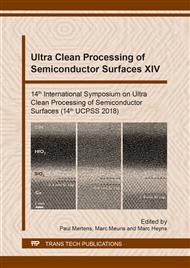[1]
A. Okuyama, S. Saito, Y. Hagimoto, K. Nishi, A. Suzuki, T. Toshima, and H. Iwamoto, Impact of electrostatic effects on wet etching phenomenon in nanoscale region, Solid State Phenom. 219 (2015) 115-118.
DOI: 10.4028/www.scientific.net/ssp.219.115
Google Scholar
[2]
G. Vereecke, H. De Coster, P. Carolan, H. Bender, K. Willems, L.-Å. Ragnarsson, P. Van Dorpe, N. Horiguchi, and F. Holsteyns, Wet etching of TiN in 1-D and 2-D confined nano-spaces of FinFET transistors, SPCC, 27-29 March 2017; Austin, TX, USA (to be published in Microelectronic Eng.).
DOI: 10.1016/j.mee.2018.09.004
Google Scholar
[3]
K. Mawatari, T. Tsukahara, Y. Tanaka, Y. Kazoe, P. Dextras, T. Kitamori, Extended Nanofluidic Systems for Chemistry and Biotechnology, Imperial College Press, London, UK, 2012, pp.121-147.
DOI: 10.1142/p813
Google Scholar
[4]
K. Mawatari, Y. Kazoe, H. Shimizu, Y. Pihosh, and T. Kitamori, Extended-nanofluidics: Fundamental technologies, unique liquid properties, and application in chemical and bio analysis methods and devices, Anal. Chem. 86 (2014) 4068-4077.
DOI: 10.1021/ac4026303
Google Scholar
[5]
Y. Kazoe, K. Mawatari, Y. Sugii, and T. Kitamori, Development of a measurement technique for ion distribution in an extended nanochannel by super-resolution-laser-induced fluorescence, Anal. Chem. 83 (2011) 8152-8157.
DOI: 10.1021/ac201654r
Google Scholar
[6]
C.-C. Chang, Y. Kazoe, K. Morikawa, K. Mawatari, R.-J. Yang, and T. Kitamori, Numerical simulation of proton distribution with electric double layer in extended nanospaces, Anal. Chem. 85 (2013) 4468-4474.
DOI: 10.1021/ac400001v
Google Scholar
[7]
A. Hibara, T. Saito, H. Kim, M. Tokoshi, T. Ooi, M. Nakao, and T. Kitamori, Anal. Chem. 74 (2002) 6170.
Google Scholar
[8]
K. Morikawa, Y. Kazoe, K. Mawatari, T. Tsukahara, and T. Kitamori, Dielectric constants of liquids confined in the extended nanospace measured by a streaming potential method, Anal. Chem. 87 (2015) 1475-1479.
DOI: 10.1021/ac504141j
Google Scholar
[9]
T. Tsukahara, A. Hibara, Y. Ikeda, and T. Kitamori, NMR study of water molecules confined in extended nanospaces, Angew. Chem., Int. Ed. 46 (2007) 1180-1183.
DOI: 10.1002/anie.200604502
Google Scholar
[10]
R. Vos, C. Rolin, J. Rip, T. Conard, T. Steylaerts, M. Vidal Cabanilles, K. Levrie, K. Jans, and T. Stakenborg, Chemical Vapor Deposition of Azidoalkylsilane Monolayer Films, Langmuir 34 (2018) 1400-1409.
DOI: 10.1021/acs.langmuir.7b04011
Google Scholar
[11]
H. Schonherr, C. Feng, and A. Shovsky, Interfacial Reactions in Confinement: Kinetics and Temperature Dependence of Reactions in Self-Assembled Monolayers Compared to Ultrathin Polymer Films, Langmuir 19 (2003) 10843-10851.
DOI: 10.1021/la034887z
Google Scholar
[12]
G. Vereecke, X. Xu, W.K. Tsai, H. Yang, S. Armini, T. Delande, G. Doumen, F. Kentie, X. Shi, I. Simms, K. Nafus, F. Holsteyns, H. Struyf, and S. De Gendt, Partial Wetting of Aqueous Solutions on High Aspect Ratio Nanopillars with Hydrophilic Surface Finish, ECS J. Solid State Sci. Technol. 3 (2014).
DOI: 10.1149/2.013401jss
Google Scholar
[13]
N. Vrancken, S. Sergeant, G. Vereecke, G. Doumen, F. Holsteyns, H. Terryn, S. De Gendt, and X. Xu, Superhydrophobic Breakdown of Nanostructured Surfaces Characterized in Situ Using ATR−FTIR, Langmuir 33 (2017) 3601−3609.
DOI: 10.1021/acs.langmuir.6b04471
Google Scholar
[14]
M. R. Yalamanchili, A. A. Atia, and J. D. Miller, Analysis of Interfacial Water at a Hydrophilic Silicon Surface by in-Situ FTIR/Internal Reflection Spectroscopy, Langmuir 12 (1996) 4176-4184.
DOI: 10.1021/la950340b
Google Scholar
[15]
D. Bottenus, Y.-J. Oh, S.M. Han, and C.F. Ivory, Experimentally and theoretically observed native pH shifts in a nanochannel array, Lab on Chip 9 (2009) 219-231.
DOI: 10.1039/b803278e
Google Scholar
[16]
D.F. Evans and H. Wennerstrom, The Colloidal Domain, 2nd ed., Wiley-VCH, 1999, p.134.
Google Scholar
[17]
D.A. Skoog and D.M. West, Fundamentals of Analytical Chemistry, 4th ed., Holt-Saunders Int. Ed., (1982).
Google Scholar
[18]
C.S. McKay and M.G Finn, Click Chemistry in Complex Mixtures: Bioorthogonal Bioconjugation, Chemistry & Biology 21 (2014) 1075-1101.
DOI: 10.1016/j.chembiol.2014.09.002
Google Scholar
[19]
G.I. Anderton, A.S. Bangerter, T.C. Davis, Z. Feng, A.J. Furtak, J.O. Larsen, T.L. Scroggin, and J.M. Heemstra, Accelerating Strain-Promoted Azide−Alkyne Cycloaddition Using Micellar Catalysis, Bioconjugate Chem. 26 (2015) 1687-1691.
DOI: 10.1021/acs.bioconjchem.5b00274
Google Scholar
[20]
G.M. Barrow, Physical Chemistry, 4th ed., McGraw-Hill, 1979, p.768.
Google Scholar


